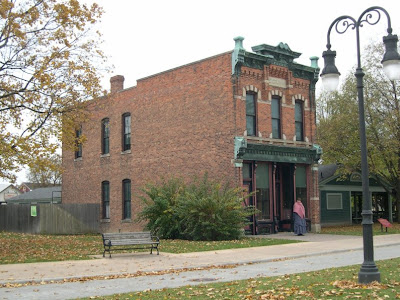Greenfield: The Early American Village
"This is the only reason Greenfield Village exists - to give us a sense of unity with our people through the generations, and to convey the inspiration of American genius to our youth. As a nation we have not depended so much on rare or occasional genius as on the general resourcefulness of our people. That is our true genius, and I am hoping that Greenfield Village will serve that."
Henry Ford
The Grand Opening of Greenfield Village took place on October 21, 1929, a date purposely chosen by Henry Ford to celebrate the electric light's golden jubilee (50 years!). A reason to honor his friend, Thomas Edison.
The visiting dignitaries on that rainy October 21 morning saw a muddy, virtually treeless village of about 30 buildings. Besides Mr. Edison, guests included President Hoover, Madam Curie, Orville Wright, Will Rogers, and John D. Rockefeller - among many others. They arrived at Smith's Creek Depot on the locomotive known as the Sam Hill (now located inside the Henry Ford Museum). Despite the rain a crowd had gathered to get a glimpse of the honored guests. Because of the wet and muddy conditions, Ford provided horse-drawn covered carriages for his guests, and they were soon transported to various locations around the Village. Ford had his employees dressed in "period costume" to help provide atmosphere and had others riding along the dirt roads on the high wheel bikes so prominent in the late 19th century.
Evening came and the honored guests were taken to the replica Independence Hall that Ford had built as the entrance to his indoor museum for a banquet to honor Edison and his many accomplishments, but especially the electric light. As there were plans to have Edison reenact the lighting of his first incandescent bulb 50 years earlier, Ford allowed no electric lighting until after the reenactment was over, so the entire banquet hall was lit with candles dipped in the Village.
Ford, Edison, and President Hoover left after dinner for the reconstructed Menlo Park by way of carriage through kerosene-lit streets. NBC radio described the events in a live broadcast that was heard across the entire nation. It was asked of the listeners to turn off their electric lights until the reenactment of the momentous occasion occurred, then everyone was to turn on their light switches to mark the anniversary.
Here is part of NBC's description of what happened as was heard nationwide:
"Will it light? Will it burn? Or will it flicker and die, as so many previous lamps had died? Now the group (Hoover, Edison, and Ford) is about the old vacuum pump. Mr. Edison has two wires in his hand; now he is reaching up to the old lamp; now he is making the connection...It Lights!"
The museum's replica of the Liberty Bell pealed for the first time. Electric lights blinked on across the nation; car horns sounded. The world showed it's gratitude - none more deeply than Ford. More important than dedicating his beloved Village and museum was the opportunity to honor the man who not only encouraged his first car, but had made possible great advances in industrial technology for the benefit of the entire world. Ford's new institution, formally named The Edison Institute, had been properly christened. (From Henry Ford Museum & Greenfield Village: An Illustrated History with revised text by Harold Skramstad Jr. 1993.)
Ford instructed a worker to nail the chair that Edison sat upon during the lighting reenactment to the floor to permanently - it's there still.

The very spot Edison sat while recreating his historic incandescent lamp lighting on October 21, 1029. The chair is still nailed to the floor.
After the grand opening, Ford continued collecting buildings and the whole Village was always in a state of change. Structures were moved and removed, ideas were initiated and, in many cases, terminated. Having a Seminole Indian Village was one such idea, as was having a bird sanctuary. Another plan was to have people live and work in Greenfield Village, performing traditional tasks and crafts. Although the Humberstone family lived in the Sarah Jordan Boarding House and a man named W.W. Taylor lived at the Smiths Creek Depot, serving as "living exhibits," the idea proved impractical and Ford discontinued it.
He did, however, continue to have craftsmen during the day.
The original purpose for Greenfield Village, from Henry Ford's point of view, was for educational purposes. He felt the best way for the country's youth to learn was by doing - by experiencing things first-hand. With this in mind, he turned numerous structures into classrooms, where school children studied daily in an "inventive atmosphere," and hoped the inspiration of those who came before would continue to inspire the children in a very positive way.
The Village ran this way until 1969.
Interest from the general public grew, from 400 inquiries a day in 1929 to over 1000 a day in 1933.
Finally, Ford relented, and on June 22, 1933, Greenfield Village opened its gates to the public for the very first time. The cost was 25 cents to enter.
What I have in the other postings in this blog are the structures that were erected after 1929.
To learn about each individual structure placed inside the village (and much much more), please click HERE.
To see actual black and white movies (silent, of course) taken during this momentous occasion on October 21, 1929, click HERE
.




Comments